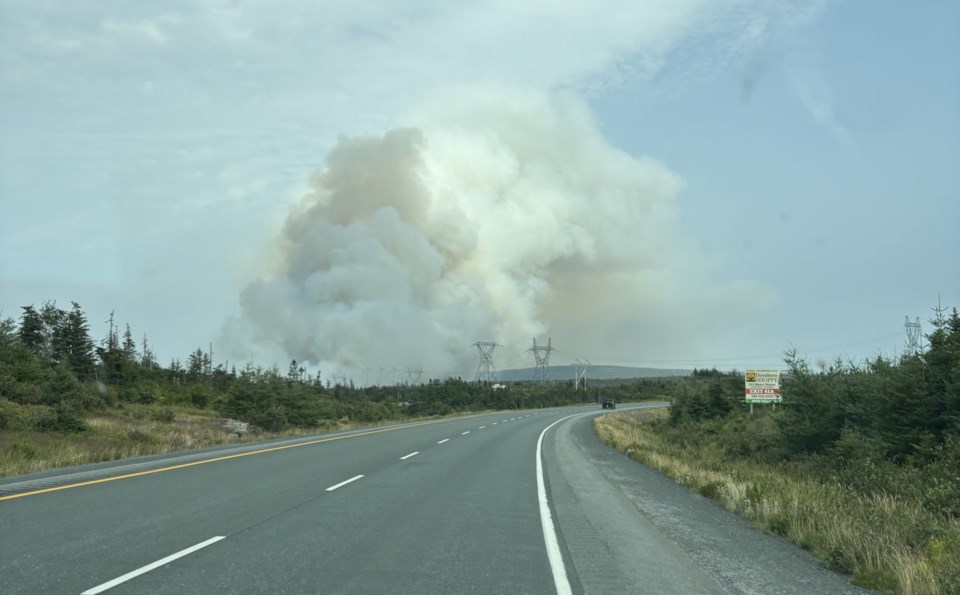ST. JOHN'S — Residents near Newfoundland and Labrador's largest city were ordered to flee a wildfire Tuesday, as thousands of other people across the province faced the prospect of leaving or losing their homes to flames.
Officials ordered evacuations in some parts of Paradise, a suburb of the capital St. John's. The news came barely an hour after Premier John Hogan said a fire had ignited in Spaniard's Bay, N.L., adding to a seemingly relentless series of wildfires erupting amid a spate of dry, sweltering heat.
Sharlene Johnson, a 48-year-old single mother living near St. John's in Conception Bay South, said the fire situation in the province is unlike anything she has ever seen. Her home was part of a sweeping evacuation alert announced Monday, which expanded to include roughly 20,000 people on Tuesday afternoon.
"I’m kind of just a sitting duck right now, waiting to see and reading news updates,” she said in an interview Tuesday. "I do worry about things like if I have to leave here or if my home was to burn down. It’s something that is now very real to me and it’s terrifying."
Much of Atlantic Canada has been gripped by unusually hot and dry weather this summer, stoking the conditions for extreme wildfire risk. There were at least four out-of-control fires burning across Newfoundland and Labrador Tuesday, including a wildfire near Kingston, N.L., along the northeastern shore of Conception Bay, which encompassed 64 square kilometres.
The Kingston fire had driven about 3,000 people from their homes as of Monday and destroyed an unknown number of houses.
The fire that prompted the evacuations in Paradise ignited on Monday afternoon, roughly 15 kilometres south of St. John’s, near Paddy's Pond. It had grown to about two square kilometres by Monday evening.
Water bombers will share the firefighting work between the Kingston and Paddy’s Pond fires, which are fewer than 100 km apart, Hogan told reporters on Tuesday afternoon. Four additional helicopters were en route, including two Blackhawk helicopters from Utah to help with nighttime operations, he said.
It wasn't long before he had to make a post on social media to confirm the fire in Spaniard's Bay, which was burning roughly 25 km southwest of the ferocious Kingston wildfire.
"Crews are responding," Hogan wrote. "If you are in the area, please monitor official channels and stay safe."
In a separate Facebook post, the town of Spaniard's Bay issued an urgent alert imploring residents of a wooded road to evacuate.
Meanwhile, in Nova Scotia, crews were called to a fire that broke out in woodlands on the western edge of Halifax on Tuesday afternoon, not far from the Bayers Lake business park. Local authorities said a Nova Scotia Health outpatient clinic in the area was being evacuated, as was a commercial building nearby.
In New Brunswick, firefighters were battling two out-of-control wildfires. Residents north of Moncton were told to prepare for evacuation. Despite parched conditions in much of the province, there were no evacuations as of Tuesday, and no homes or other structures had been lost.
Environment Canada extended heat warnings across Atlantic Canada until at least Wednesday, with the exception of the southern reaches of Newfoundland. In eastern Newfoundland, the humidity was expected to make temperature feel like 41 C in some areas.
Agriculture Canada said Tuesday that 56 per cent of Atlantic Canada was classified as abnormally dry, with 90 per cent of Nova Scotia in a moderate drought. The statistics also show that St John’s has received only one-third of the rain it usually gets between April and July. In Halifax, the figure is about 40 per cent.
This report by The Canadian Press was first published Aug. 12, 2025.
— With files from Michael MacDonald and Keith Doucette in Halifax.
Sarah Smellie, The Canadian Press




